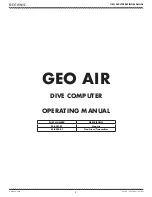
8
importance for accuracy of the calibration.
All current elements should be wired the
same way, and all voltage elements should be
in phase. The only exception to this rule
would be for 2 1/2 element transducers,
which are sometimes used in order to save
the cost of one potential transformer. The
missing potential input is accounted for
mathematically, so during calibration one of
the current transformers must be reversed,
and special calculations apply. When
calibrating 2 1/2 element transducers, the
product documentation for the device should
be consulted for proper procedures.
Phase Angle
Wiring connections for phase angle
transducers used in three-phase systems at
first glance may appear somewhat
unorthodox. Typically, a single voltage
element and a single current element are
used. The current element is placed in series
with one of the phases, or, if used, a current
transformer is placed around the conductor
for that phase. The voltage element is wired
between the remaining two phases,
sometimes employing a potential
transformer. Refer to figure 11a for a typical
application circuit. If the phase angle
between the voltage and the current in the
circuit is zero, the net voltage between the
two measured phases (or the output voltage
of the potential transformer) will be offset
from the current measured in the third phase
by 90 degrees. The two input signals are
compared internally, and a dc voltage
corresponding to the phase angle is output
from the transducer.
Connections for use of a 1040C to
calibrate this type of phase angle transducer
are shown in figure 11b. The 1040C voltage
output leads are connected to the voltage
terminals of the transducer, and the 1040C
current output leads are connected to the
current input terminals of the meter or
transducer. If the transducer uses an external
current transformer, one of the current output
leads of the 1040C should be passed through
the center of the current transformer, and
then shorted to the other lead. If the meter or
transducer uses an external potential
transformer, then likewise it must be inserted
between the 1040C voltage output leads and
the input voltage leads of the unit under test.
The 1040C should first be configured to
operate in the ac power mode, and the
appropriate voltage and current values should
be selected. Next, a calibration phase angle
value must be entered, keeping in mind that
for indication of zero phase from the
transducer output, the input voltage must be
offset from the input current by 90 degrees
(whether this is a lead or lag condition
depends on the individual transducer
manufacturer. The calibration procedure for
the phase angle transducer can now be
performed. For more complete instructions
on operation of the 1040C for phase angle
calibrations, refer to section 2.5.1 of the
operation manual.
Power Factor
In order to accomplish power factor
indication, some transducer manufacturers
recommend using one of their phase angle
transducers and performing a mathematical
conversion on the output signal. This can be
done manually, using conversion tables
supplied by the manufacturer, or
automatically using a meter having cosine
scaling. If a phase angle transducer is
employed for this purpose, the connections
will be the same as those illustrated in figure
11.
Power factor output is also commonly
available as an additional feature on single
and multi-phase watt transducers. In this
case, the transducer is connected in the same
manner as a conventional multi-phase watt
transducer (refer to figure 9).











































